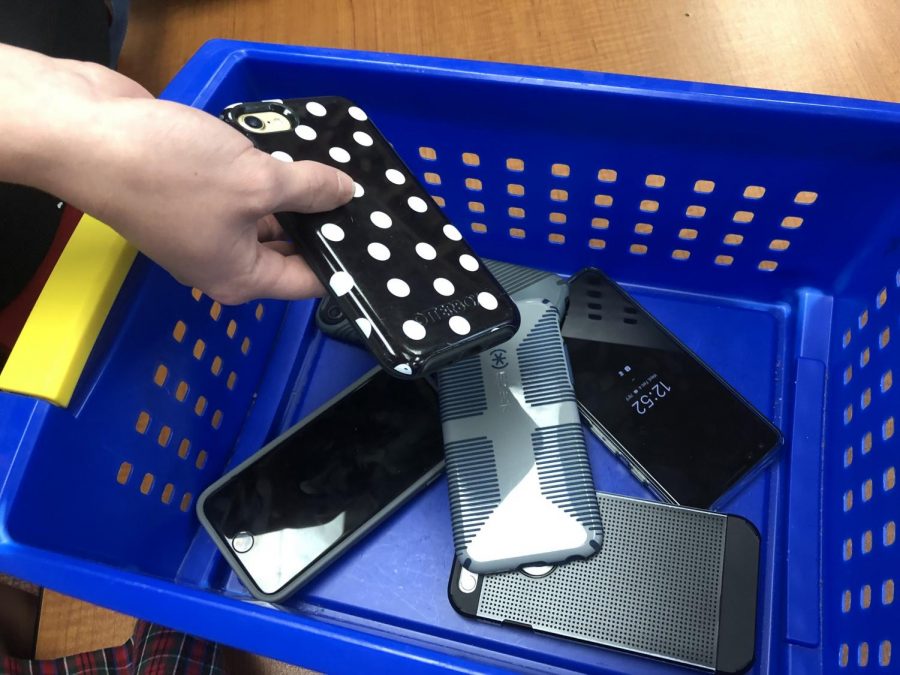Why students’ phones should be collected during class
Students placing their phones in a collection box before class.
With five minutes left in the period, the students were deeply focused. Their work required the utmost attention to detail. Thinking quickly and efficiently, they strove to execute their task. However, their assignment wasn’t given by their teacher. In fact, it wasn’t even part of the class. The object of their attention was not a notebook, worksheet or novel, but a phone.
Situations like this occur many times in my own, and likely your, day-to-day life at school. Phones seem to grab our attention as much as anything else in class. Their glowing screens provide as much stimulation—and distraction—as we desire. With that in mind, I believe that St. John’s should enact a simple yet bold policy: Students should put their phones in a collection area at the beginning of class and pick them up at the end.
Quite simply, the presence of cellular devices does not contribute to an engaged, participating and focused class. Using a phone during class impairs discussion among students and with the teacher. Since contributing to class dialogue is largely a voluntary activity, students who feel that they have more exciting ways to spend their time during lessons will do so if they have access to their phones. Why would a student, when presented with these two choices, pick the one they consider less interesting?
One may ask, “Why does it matter if a student want to voluntarily compromise his or her education?” It matters because hearing differing viewpoints and diverse opinions and generally engaging in discourse is one of the most important parts of being in a class. Without the input of their peers, students will not be able to correct their own mistakes, ameliorate their arguments or learn from others. Phones in classrooms, therefore, present a two-pronged problem: Not only do they distract students, but they impair classroom discussions, which are critical to better understanding material.
The encroachment of phones into our classrooms has been clearly noticeable to me from the transition to high school from middle school, where phones are not allowed in class or even outside of lockers. During middle school English classes, students would eagerly share their opinion on the novel we were reading, almost cutting each other off for the chance to contribute. In high school, however, students—myself included—sometimes have to be prodded to answer questions because the class is disengaged and on their phones.
Furthermore, the ability to use phones in classrooms encourages students to settle for the least amount of work possible and precludes them for striving for their best. “If I can just get this done,” a student might think, “I’ll be able to use my phone again.” On the other hand, a student who doesn’t have such a distraction would use their extra time to go above and beyond in their work, not rush through problems or reading and generally gain a deeper understanding of the task at hand.
These issues don’t even include the noise that phones can make, which disrupts the class’ flow. It’s frustrating when that ubiquitous dinging sound rings out during a focused reading, explanation or discussion. Recently, I was in a class while the teacher was lecturing, and a pinging noise interrupted us in the middle of a key point. The entire class sat silently while it died down, and an embarrassed student quickly silenced his phone.
Some might contend that phones have useful features which could add value to schoolwork. While some classes, especially those related to videography, might need them, most definitely don’t, especially on a daily basis.
However, certain students don’t actively use their phone, but rather have it on hand to be able to respond to anything they might receive. This passive usage problematically breaks focus by demanding the attention of students. According to a study from the University of California at Irvine, the brain needs about 25 minutes of uninterrupted work to achieve focus. Just two phone checks per class can prevent us from ever getting there. The same study found that returning to work after being distracted significantly increases mental workload, stress and frustration.
Phones are great at many things: giving directions, taking pictures and communicating with our friends. It’s no surprise they’ve gradually become a bigger part of our lives. That being said, they are not devices which allow us to work in a focused and uninterrupted way. Let’s keep using phones to make us safer, more informed and better connected. During class time, however, let’s put them where they belong—out of sight and out of mind.

Max is a senior in his fourth year on Review. He likes to repair watches and his favorite pizza is onion-pineapple.

Fareen Dhuka is a senior in her fourth year on Review. Her dream vacation is going to Disney World with Laney and she can't stop making overnight oats.















Cheryl Hayes • Dec 27, 2020 at 11:38 AM
Retired in January from teaching of 20 years. Totally agree that phones don’t belong in the classroom. As a teacher I modeled the rule. My phone was turned off and kept away during class time. Once students recognized I followed the same rule, there was no problem.